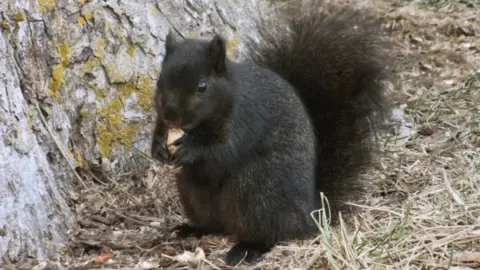Black squirrels the result of 'interbreeding' grey squirrels, study finds
 Philip Meyers
Philip MeyersBlack squirrels are the result of "interbreeding" between their grey cousins and the North American fox squirrel, a study has concluded.
Research published in BMC Evolutionary Biology found the black fur emerged from a faulty pigment gene.
The study by Anglia Ruskin University (ARU) in Cambridge say the difference between black and grey squirrels is simply the colour of their fur.
Author Dr Helen McRobie said grey and fox squirrels share the "same root".
There are thought to be around 25,000 black squirrels in the UK, with numbers largely concentrated in Bedfordshire, Hertfordshire and Cambridgeshire.
The first wild black squirrel was recorded in Woburn in 1912, and was believed to have escaped from a private zoo having been imported from the United States.
 Getty Images
Getty ImagesThe new findings build on earlier work by Dr McRobie which found that the black fur in grey squirrels is caused by a missing piece of DNA in its pigment gene.
Squirrels take part in "mating chases" and a male black fox squirrel "most likely" mated with a female grey, Dr McRobie said.
 Amanda K Ciurej
Amanda K CiurejDr McRobie, a senior lecturer in biomedical science, collaborated with researchers from the University of Cambridge and the Virginia Museum of Natural History in the United States.
She said people have mixed feelings about black squirrels with some regarding them as a "menace".
"The most likely explanation for the black version of the gene being found in the grey squirrel is that a male black fox squirrel mated with a female grey squirrel," she said.
"The fact black grey squirrels have become so common right across North America is possibly because black fur offers a thermal advantage, helping them inhabit regions with extremely cold winters.
"This may have contributed to the expansion of the grey squirrel's range during the past 11,000 years, following the end of the most recent ice age, helping them spread further north into Canada."
